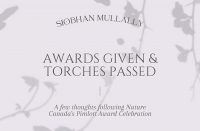“We collectively have no future unless we protect our people, especially children and youth, and our land, water, and nations. We need to always consider our future generations, and this should be at the forefront of all decision making”
– The Charlottetown Bold Vision Declaration
“We collectively have no future unless we protect our people, especially children and youth, and our land, water, and nations. We need to always consider our future generations, and this should be at the forefront of all decision making”
– The Charlottetown Bold Vision Declaration
In September 2014, 23 inspirational women met in Charlottetown, Prince Edward Island to commemorate the 150th anniversary of the Charlottetown Conference with a new “Bold Vision” for Canada. The initial Charlottetown Conference took place in 1864, when 23 men met to discuss their plans for the future of Canada. A Bold Vision complements the coalition of these male visionaries, and moreover celebrates the vital role that women play – and have always played – in the advancement of our country.
The Bold Visionaries were nominated by their peers and bring their diverse opinions, abilities and backgrounds together to establish a collective vision. There is a 70-year age gap between the youngest and the oldest participants, who come from various political spectra and represent a range of fields. At the conference, the 23 visionaries bridged their diversity in order to create The Charlottetown Bold Vision Declaration.
The declaration contains, according to participant Catherine Potvin, 17 points articulating the collective Bold Vision for the future of Canada: “the things that we need to pay attention to, in order for Canada to be where we would like it to be in 150 years.” The Bold Visionaries hope that with the presentation of this document to Canadian government ministers, the declaration will be turned into an action plan.
The declaration states that “the bounty of nature has shaped this country…. A healthy environment is one of the key legacies for the future inhabitants of the territory of Canada.” It also calls for recognition of the “oppression, disadvantage, violence and marginalization that women in all our diversity of experience.”
Women should also be involved with visualizing the next 150 years of Canadian history.
“[The visionaries] feel that still in Canada, people talk mostly of women that are dead or beaten or disappeared…it would be great to celebrate, also, women’s success,” says Potvin.
‘A Bold Vision’ celebrates the female presence in Canadian growth and progress. Bringing together these 23 Bold Visionaries recognizes that women should also be involved with visualizing the next 150 years of Canadian history. As Potvin says, “I think both sexes need each other, and I think [we] should still work quite hard for women’s vision to be out there.”
Meet the Bold Visionaries
Jessie Housty, an active member of the Heiltsuk First Nation in Bella Bella, British Columbia is passionately committed to improving the environment. Her environmental work focuses on projects that hit close to her West Coast home: deforestation, trophy hunting, energy issues, food security and sovereignty. She also works to maintain the legacy of her ancestors while looking to preserve and nurture the Earth for future generations.
Pam Palmater is also ancestrally, professionally and personally involved with the Indigenous population of Canada. She is a Mi’kmaw citizen and a member of the Eel River Bar First Nation in New Brunswick. Her great-grandfather was a Chief, and her grandmother was a traditional healer. She is currently an associate professor and Chair of Indigenous Governance at Ryerson University, and has been a practicing lawyer for 16 years. She avidly works, volunteers and engages with First Nation communities, devoting her time to their legal, social and political issues. Dr. Palmater has been nominated for numerous prestigious awards, such as the 2012 Women’s Courage Award and the Top 25 Most Influential Lawyers in Canada 2013.
Catherine Potvin is a professor in the Biology Department at McGill University and is the UNESCO-McGill Chair in Dialogues on Sustainability, a partnership between McGill University and three Panamanian institutions working to advance sustainability education, research and dialogue “in the face of global environmental change.” A\J also welcomes her as the guest editor of our new issue.
Potvin is leading a charge to foster meaningful discussion about sustainability issues here at home. As head of the Sustainable Canada Dialogues, she assembled a team of the country’s leading academics to develop recommendations to integrate environmental considerations into federal policy. They cover key topics on sustainability including environmental policy and the economy, evaluating alternative energy systems, improving water and energy consumption in cities, sustainable mining practices, possible futures of Canada’s arctic and other important issues. The result is a map to making Canada a world leader in sustainability.
A\J is thrilled to partner with Potvin and her all-star team of Canada’s brightest minds to publish some of this work in a special issue of A\J – perhaps our most important issue to date. (Watch for it on newsstands and on our web site in March!) With a federal election on the horizon this year, now is the time to speak up on behalf of the environment. As Potvin has shown us, it’s time to be bold.
Anne is A\J’s outreach and development manager. She has a BA from UBC and is currently pursuing her MA in experimental digital media at uWaterloo.
Elise Marion has a masters in Comparative Literature from Dublin City University and a bachelors degree in English and Classics from McMaster University, and is keenly pursuing a literary career.













